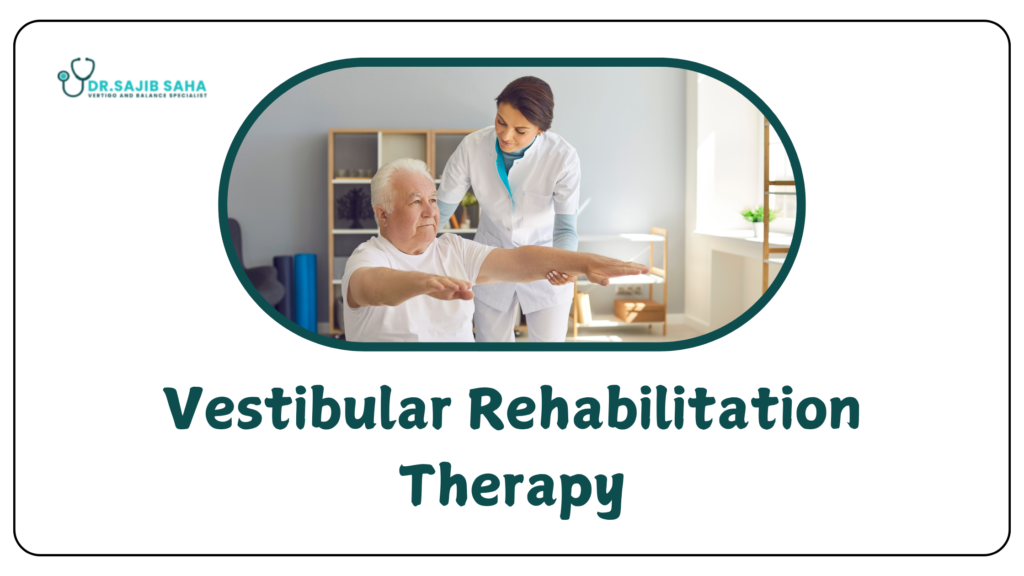Vestibular rehabilitation therapy (VRT) is a specialized form of physical therapy designed to treat vestibular disorders, including dizziness, vertigo, imbalance, and coordination issues. If you or a loved one experiences frequent dizziness or difficulty maintaining balance, VRT can provide effective relief. In this blog, we’ll explore what vestibular rehabilitation therapy is, its benefits, how it works, and why you should consider treatment with Dr. Sajib Saha.
What is vestibular rehabilitation therapy?
Vestibular Rehabilitation Therapy (VRT) is a targeted therapy program that helps individuals with vestibular system disorders. The vestibular system, located in the inner ear, works with the eyes, muscles, and joints to maintain balance and spatial awareness. When affected by injury, illness, or age-related changes, symptoms like vertigo, dizziness, and poor coordination can occur.
VRT uses specialized exercises to retrain the brain and improve the function of the vestibular system. This non-invasive, drug-free therapy is an effective solution for those struggling with vestibular disorders.
Who Can Benefit from Vestibular Rehabilitation Therapy?
VRT is beneficial for individuals experiencing the following conditions:
- Benign Paroxysmal Positional Vertigo (BPPV): A leading cause of dizziness due to calcium crystals dislodging in the inner ear.
- Meniere’s Disease: Characterized by vertigo, tinnitus (ear ringing), and hearing loss.
- Vestibular Neuritis & Labyrinthitis: Inflammatory conditions that affect balance and coordination.
- Post-Concussion Syndrome: Dizziness and balance issues following a traumatic brain injury.
- Chronic Dizziness & Unsteadiness: VRT helps manage unexplained dizziness even without a confirmed diagnosis.
- Age-Related Balance Issues: VRT improves stability and fall prevention in older adults.
If you struggle with dizziness or balance problems, VRT can help you regain stability and confidence in daily activities.
Symptoms Treated by Vestibular Rehabilitation Therapy
VRT effectively targets vestibular symptoms, including:
- Vertigo: A spinning sensation, especially with head movements.
- Dizziness & Lightheadedness: Feeling unsteady or disoriented.
- Balance Issues: Difficulty walking or standing, especially in low-light conditions.
- Nausea & Vomiting: Often triggered by vertigo.
- Vision Problems: Blurry vision or difficulty focusing while moving.
- Fatigue: Due to constant balance compensation by the body.
How Does Vestibular Rehabilitation Therapy Work?
VRT uses customized exercises to improve the brain’s ability to process balance-related signals. The main components include:
✅ Gaze Stabilization Exercises—Improve focus and visual control during head movements. ✅ Balance Training—Enhance stability and coordination with progressive balance challenges. ✅ Habituation Exercises—Reduce dizziness sensitivity by controlled exposure to triggers. ✅ Motion Sensitivity Training—Gradually improve tolerance to movements that trigger dizziness. ✅ Postural Exercises—Strengthen muscles to improve posture and reduce falls. ✅ Canalith Repositioning Maneuvers—Techniques like the Epley maneuver to treat BPPV.
Each VRT plan is customized based on individual symptoms and progress.
What to Expect During VRT Sessions?
1️⃣ Evaluation: A trained specialist, such as Dr. Sajib Saha, will assess your symptoms, medical history, and test results.
2️⃣ Personalized Plan: A customized exercise routine is created based on your condition.
3️⃣ Therapy Sessions: Exercises are performed 2-3 times a week in a clinic or home setting.
4️⃣ Progress Monitoring: Adjustments are made as your symptoms improve over time.
Sessions typically last 30-60 minutes, and most patients experience significant symptom relief with continued therapy.
Benefits of Vestibular Rehabilitation Therapy
✔ Improves Balance – Reduces the risk of falls and injuries. ✔ Reduces Dizziness & Vertigo – Minimizes symptoms over time. ✔ Enhances Quality of Life – Helps individuals regain independence in daily activities. ✔ Personalized Treatment – Tailored to your specific symptoms. ✔ Non-Invasive & Drug-Free – Safe and effective without surgery or medications. ✔ Speeds Up Recovery—Especially for post-concussion and vestibular disorders.
Why Choose Dr. Sajib Saha for Vestibular Rehabilitation Therapy?
At Dr. Sajib Saha’s clinic, we offer specialized vestibular rehabilitation programs tailored to your specific needs. Dr. Sajib Saha is a skilled vestibular therapist who uses:
✅ Targeted vestibular exercises for dizziness and balance improvement.
✅ Postural stability techniques to enhance movement control.
✅ Personalized recovery plans to help patients regain confidence.
We understand how vestibular disorders affect daily life, and we are committed to providing expert care to help you recover.
📍 Visit us at: Road 35, House 38/A, Sanmer Tower-2, Lift 13, Gulshan 2, Dhaka 1212.
📞 Contact us today to schedule your consultation!
FAQs on Vestibular Rehabilitation Therapy
❓ How long does VRT take to show results?
Most patients experience improvement within 4-6 weeks, but recovery time varies.
❓ Is vestibular therapy safe for older adults?
Yes! VRT is highly effective for age-related balance problems and fall prevention.
❓ Can VRT cure vertigo permanently?
For conditions like BPPV, proper treatment can permanently resolve vertigo.
Conclusion
Vestibular rehabilitation therapy (VRT) is a game-changer for those suffering from dizziness, vertigo, and balance disorders. If you or a loved one struggles with these issues, seeking professional help can restore balance and improve quality of life.
Take the first step toward recovery today!
👉 Schedule an appointment with Dr. Sajib Saha and start your journey to better balance.
Want to read more blogs?
